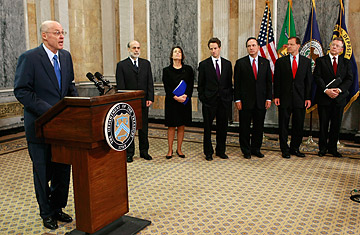
From left: Treasury Secretary Henry Paulson, Federal Reserve Chairman Ben Bernanke, FDIC chairwoman Sheila Bair, Federal Reserve Bank of New York CEO Timothy F. Geithner, Christopher Cox of the SEC, Commodity Futures Trading Commission chairman Walter Lukken and Office of Thrift Supervision director John M. Reich talk about the market-stability initiative at a news conference at the Treasury Department
On Monday, Treasury Secretary Henry Paulson, Federal Reserve Chairman Ben Bernanke and FDIC chairwoman Sheila Bair announced a widely expected effort to inject $250 billion in government funds into the troubled U.S. banking system. The goal: to get banks lending again and keep the economy from grinding to a halt. The funds will come out of the $700 billion bailout package already passed by Congress.
Symbolically, it's a powerful move: the U.S. is putting the strength of the Treasury and the wealth of the American people behind the U.S. banking system. It is literally powerful too: Treasury is about to release the financial equivalent of a high-pressure water hose to lubricate the stagnant banking system. World stock markets responded positively to news of the deal.
But there are still many unanswered questions as to how the plan can restore confidence. And for consumers, the effect of the latest move will be hard to gauge, since it is designed merely to ease the sting of the coming economic recession — meaning there will still be job losses, bank closures and business failures.
The plan calls for Treasury to inject billions of dollars into the banking system. Paulson is requiring the nine biggest lenders in the country — including Bank of America, Citigroup and JPMorgan — to sell $125 billion of preferred shares to the taxpayer and to commit in return to lending out much of that money. That should have an immediate effect in reviving the lending business. Treasury is making another $125 billion available to smaller banks on the same terms.
To make this acceptable to taxpayers, Treasury is requiring banks to pay a guaranteed 5% annual dividend on the money they're receiving. That will jump to 9% after five years. That means the banks are still getting cheap money by market standards, but it's not free money.
Treasury has also tried to structure the deal so that banks have an incentive to raise private capital to buy back the shares from the government. Private investors can get the same terms as the government, but not better terms, according to a Treasury official. It's not clear how eager private investors will be to jump in. And in theory, if the banks' stock prices rise, the taxpayer would benefit as the government is bought out.
A bigger question: Is there enough money to pay for everything the government is proposing? The new plan accounts right off the bat for a big hunk of the $700 billion that Congress approved. Will there be enough left over to buy up the toxic debts in the financial sector, for which the $700 billion was originally designed? Some analysts have estimated that those bad debts could total well over $1 trillion. It would be politically unappealing, to say the least, for the Administration to have to go back to Congress for more bailout money.
The other significant parts of the new plan are funded from other sources, and won't add to the taxpayer tab. The Federal Deposit Insurance Corporation (FDIC) will guarantee certain bank accounts — those mostly used by businesses for payroll and other expenses — above the current $250,000 limit. The FDIC will also guarantee lending between banks by creating a new kind of debt. The FDIC is calling this program a "Temporary Liquidity Guarantee."
In theory, these programs should directly reassure businesses and banks that it's safe to borrow and lend. But the programs are not directly funded by the government, and rather will function as insurance paid for by premiums paid by the banks themselves. It may work, but it's not the same as having full taxpayer guarantees.
How well and how quickly the new programs translate into confidence — meaning renewed lending by and among banks — will determine how badly the real economy is hit: how many people will lose their jobs, how many businesses will close, how many banks will fail. Everyone from Paulson on down acknowledges that those numbers will rise dramatically in the coming months. But the latest plan is meant to lessen the impact. As Paulson said this morning, "Today's actions are not what we ever wanted to do, but today's actions are what we must do to restore confidence in our financial system."
